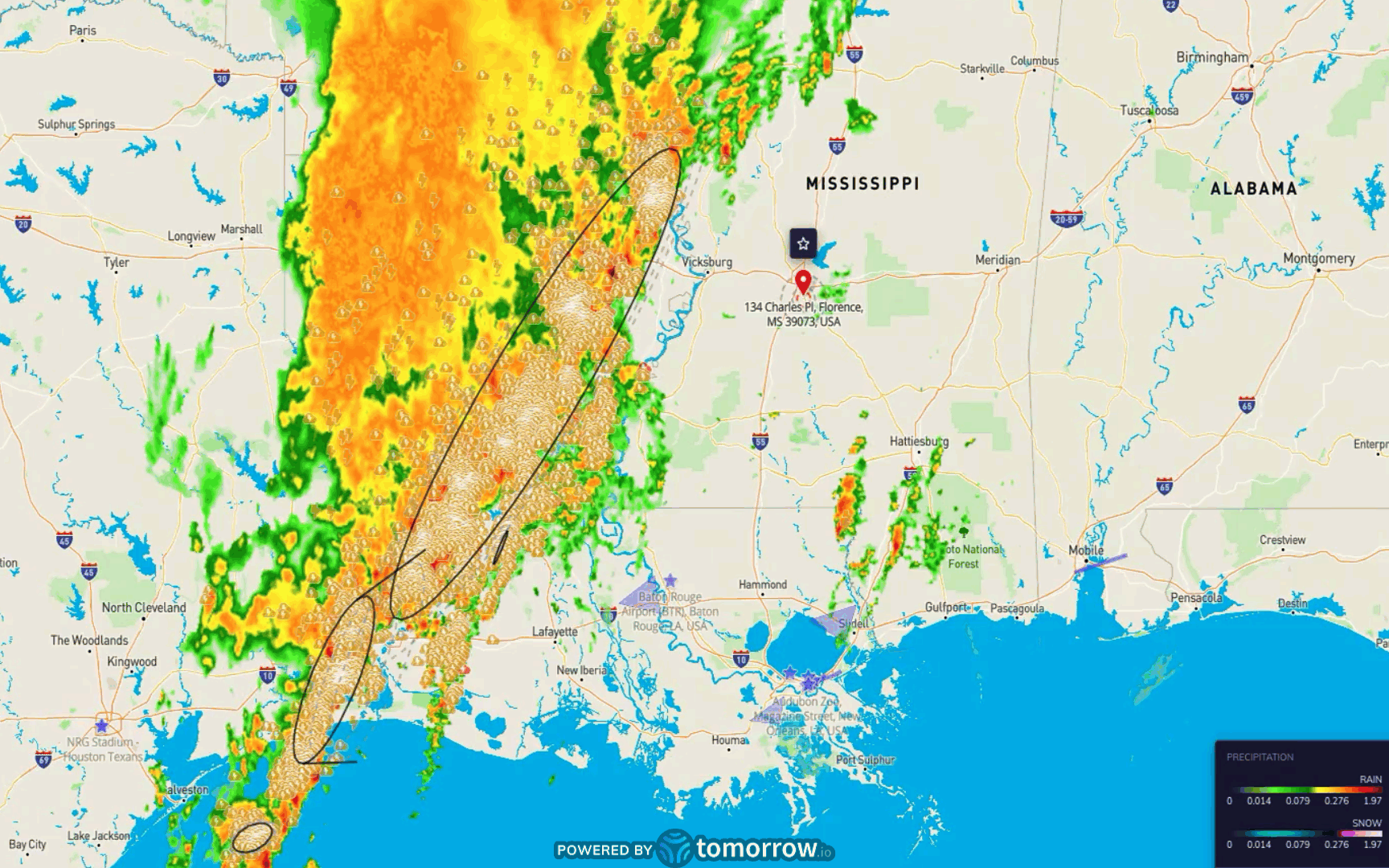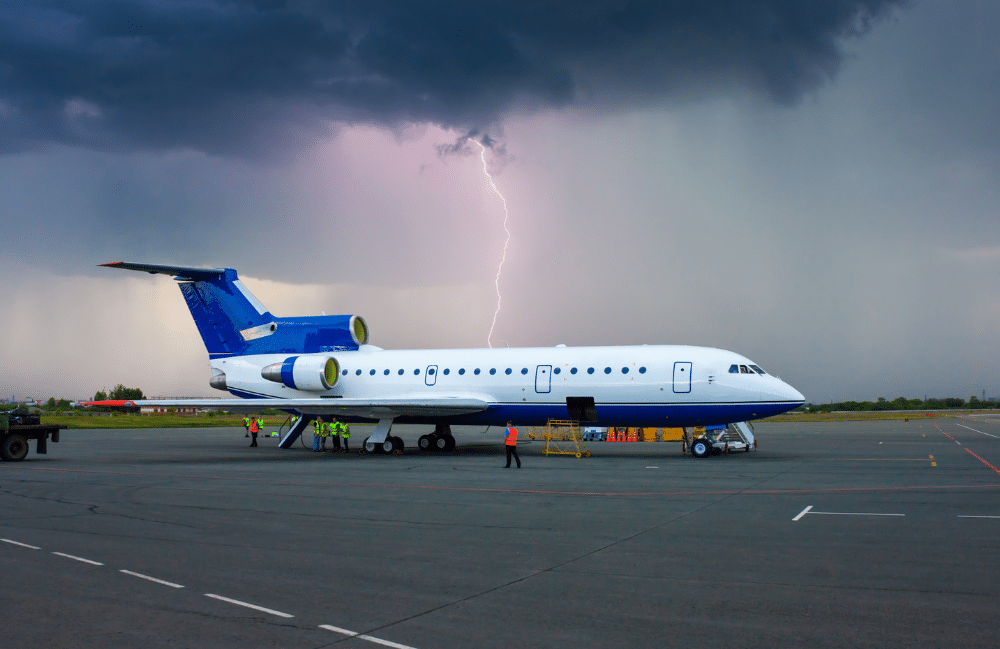TL;DR:
- Lightning is a dangerous threat to aviation operations, with aircraft being struck once every 1,000 flight hours.
- Lightning can cause physical damage, structural impact, and fuel system concerns on aircraft.
- Ground crews are at higher risk than aircraft, with around 300 people struck by lightning annually.
- Lightning-related incidents can lead to flight delays and infrastructure damage at airports.
- Tomorrow.io’s advanced lightning alert system revolutionizes lightning monitoring in aviation, providing pinpoint data to enhance safety and efficiency.
Lightning is a spectacular display of the raw power of nature, full of beauty and wonder.
Unfortunately, lightning is also one of the most dangerous weather phenomena when people are exposed in the open. Thankfully, very few people die from lightning strikes. According to the Centers for Disease Control and Prevention (CDC), there have only been 444 lightning strike deaths over the past twenty years. This is due to a cultural abundance of caution—stay inside, seek shelter, and get out of the water when you hear thunder, etc.
Despite our relative safety from lightning, strikes can cause significant disruption in certain industries, including aviation.
In aviation, standard operating procedures have always been to shut down operations when lightning is within five nautical miles and resume them once it passes.
Tomorrow.io is revolutionizing the lightning alert process to reduce time wasted by providing pinpoint data on the location of the observed lighting and the track it’s taking. The result is your organization eliminating downtime associated with lightning warnings.
This blog highlights the impact of lightning on aviation and how the industry is combatting the threat with AI-driven weather insights.

Tomorrow.io’s Map shows both cloud-cloud and ground-to-cloud lightning,
How Does Lightning Threaten Aviation Operations?
Lightning poses a significant threat to aviation operations in the air and on the ground. Here are a few statistics to keep in mind:
- Aircraft are struck by lightning once every 1,000 flight hours
- Lightning strikes are most common during the climb and descent phases of flight, between 5,000-15,000 feet altitude.
- The risk of being struck by lightning drops significantly above 20,000 feet.
- Lightning strikes can occur even without nearby thunderstorms, with almost half of the reported strikes happening when no thunderstorms were present.
Lightning Effects on Aircraft
Lightning strikes on aircraft are pretty standard, mostly occurring when aircraft are in the clouds. These days, aircraft are designed with key features to protect them from lightning, such as a conductive airframe and surge protection. However, lightning strikes are still known to splinter nose cones, craze windscreens, and damage other composite components. Lightning can have both direct and indirect effects on the plane.
Direct Effects
- Physical Damage: Lightning can create scorch marks, pits, and small holes in the fuselage due to the high temperatures and pressures generated during the strike.
- Structural Impact: The lightning current can flow along the exterior of the aircraft, potentially damaging antennas, radomes, and other protruding components.
- Fuel System Concerns: To prevent sparks that could ignite fuel vapors, the aircraft’s fuel system must be well-protected against lightning-induced damage.
Indirect Effects
- Electronic Interference: Lightning strikes can induce transients into wires and equipment, leading to temporary flickering of lights or instrument interference in the cockpit.
- Sensitive Equipment Protection: Critical systems like electrically controlled fuel valves, generators, and power feeders may be damaged by high-intensity lightning strikes, necessitating surge protection measures.
- Composite Material Challenges: Modern aircraft with composite parts require additional lightning protection due to their lower conductivity compared to metal structures.
Lighting Effect on Ground Crews
Lightning can become much more difficult to avoid in the terminal area en route because there is little (if any) room for course deviation in the terminal area. For example, if a jet is riding the glideslope on an Instrument Landing System (ILS), the jet cannot deviate. Therefore, if they encounter lightning along the instrument procedure, it is best to ride it to the ground rather than go around and go into a holding pattern for a missed approach.
The ground crew personnel are at a higher risk than the aircraft (remember, aircraft are designed to absorb and disperse lightning strikes). Around 300 people are struck by lightning annually, some of which have been at airports.
There is alarmingly little information on safety protocols at airports regarding lightning safety. The default is OSHA guidance on the matter, which is extremely vague. If you can hear thunder, you need to go inside and not come back out until 30 minutes after the last rumble is heard.
Lighting Effects On Operations Control Center
The FAA’s NextGen Weather Program indicates that weather-related delays account for 75% of all weather delays greater than 15 minutes. Here’s how it impacts the OCC as a whole:
- Infrastructure Damage: Lightning strikes at airports can cause minor to substantial destruction, resulting in millions of dollars worth of damage to critical infrastructure like air traffic control towers and other facilities.
- Worker Safety: Airport personnel, including baggage handlers, fuel suppliers, mechanics, maintenance workers, and passengers, are at risk during lightning storms. Tragic incidents have occurred where individuals have been injured or killed by lightning strikes near or on airport premises.
- Flight Delays: Lightning-related incidents can lead to flight delays due to safety concerns and the need for thorough inspections of aircraft and facilities after a strike. Infrastructure damage can also contribute to operational disruptions.
To mitigate the disruption of weather, airport operations must have access to technology that alerts them of incoming lightning strikes and storms in advance.
Quantifying The Impact of Lightning on Aviation
So, how does one prepare for lightning in an airport setting?
The Federal Aviation Administration (FAA) has some guidelines along with individual airport policies. Unfortunately, the OSHA guidance is of little to no use when running any serious operation since it does not specifically mention lightning and airports.
To be more proactive about lightning strikes, you need to know specific parameters to ensure that two things happen:
- First, personnel are safely indoors when lightning is in the area.
- Second, personnel do not spend more time than necessary in sheltering.
The Cost of Delays On Airlines
Every minute counts in the aviation industry. Time is money. The cost of delaying operations when things could have stayed in operation is not cheap. So much so that every minute delay costs, on average, $110.
In fact, U.S. flight delays cost airlines an estimated $30 billion annually.
With weather intelligence technology, airlines can reduce delays and ultimately reduce their costs.
Advanced Lightning Alert System: Enhancing Aviation Safety
So, how can airports and aviation organizations better protect staff and passengers?
With weather intelligence that leverages AI-backed weather modeling to provide lightning alerts ahead of time.
Tomorrow.io is at the forefront of using advanced lightning alerts to provide airport operators, air traffic control, and airline dispatchers the ability to predict lightning with far improved certainty than relying on legacy weather warnings.
Watch to learn how Tomorrow.io’s Real-Time Lightning Alerts can optimize safety and efficiency.
Revolutionizing Lightning Monitoring in Aviation
Traditional weather watches and warnings often lack the precision needed to make informed decisions, leaving operations with only a general idea of the impending weather.
Tomorrow.io is revolutionizing how organizations handle weather-related challenges by providing highly localized and customizable weather alerts.
By tailoring weather alerts to an organization’s specific parameters, protocols, and thresholds, Tomorrow.io ensures that the right information reaches the right people at the right time.
Weather intelligence offers:
- Real-time lightning strike information
- Storm direction and timing rings for selected functional areas
- Personalized dashboards with customizable range rings
- Precise monitoring of when to clear the apron and bring in personnel
Air traffic control can gain significantly from increased accuracy and granularity of weather intelligence insights. With a more precise understanding of how lightning impacts terminal procedures, air traffic controllers can make better-informed decisions about landing and departure operations.
Check out the latest in lightning at Tomorrow.io below.
A Weather-Intelligent Future
Severe weather is the age-old nemesis of flying, and thunderstorms are especially dangerous. Current warning and forecasting are built around the broad area concept, which affords far more cushion in timing than is necessary; a storm in the same county as the airport may never come within ten miles of the airport and has no operational impact at all, yet it is still a warned storm.
Tomorrow.io is changing the archaic framework by providing you with pinpoint solutions.






